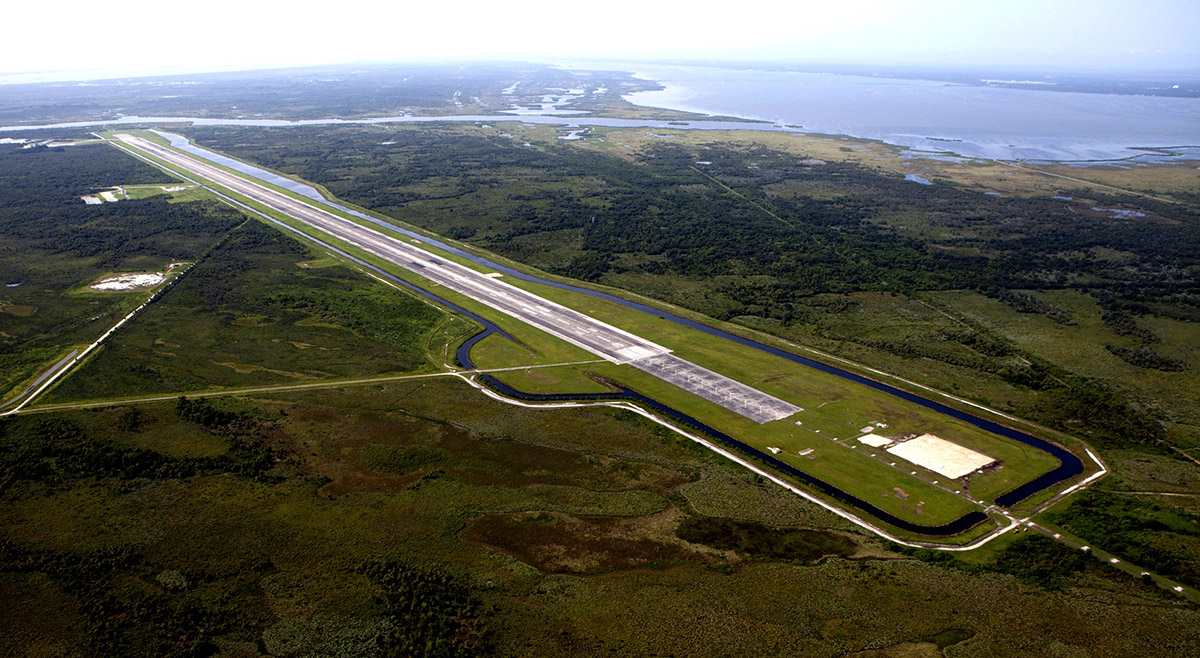
Shuttle Landing Facility
Kennedy Space Center’s historic Shuttle Landing Facility (SLF), the site of one of the longest runways in the world, is available for use by external customers. The runway and associated facilities are operated and managed by Space Florida, the state’s aerospace economic development agency, under a 30-year property agreement with NASA.
The goal of this agreement is to maximize opportunities to utilize the runway creatively while maintaining its ability to serve NASA and the center during the ongoing transformation to a multi-user spaceport. Contact Space Florida or visit their website HERE.
The 15,000-foot runway is set in a secure location providing year-round access to restricted airspace that is well away from populated areas. With an air traffic control tower and all the supporting services and equipment necessary for take-off and landing, the SLF is capable of supporting all types and sizes of aircraft and planned horizontal launch and landing vehicles. It is ideal for horizontal flights, suborbital flight training and research, weightless flights, and aviation and aerodynamic flight testing. Features include:
- Access to restricted airspace
- Located away from populated areas
- Single runway
- 33 (northwest)/15 (southeast)
- 15,000 feet long and 300 feet wide
- 1,000 feet overrun on each end
- High friction concrete (middle 8,500 ft) with paving thickness of 16 inches at center
- Grooved runway (middle 8,500 ft) to provide drainage
- Air traffic control tower
- Ground to air communications
- Built to FAA standards
- On-site ARFF Class D fire and emergency response services
- Navigational/landing aids
- Published GPS approaches to runway 33 and 15
- PAPI system
- Distance-to-go markers
Current/Compatible Uses
- Horizontal launch and landing
- Suborbital flight training and research
- Weightless flights
- Test-flight aviation
- Straight-line aerodynamics testing
Horizontal Launch and Landing Area Development Plan
- Prime aerospace/aviation-designated land and some existing facilities available for development
- Supporting both Government and commercial spaceflight
- Orbital / suborbital
- Crewed / uncrewed
- Potential for development of:
- Multiple hangars with offices and shops
- Passenger processing/training and operations facility
- Assembly, processing and manufacturing facility
- Propellant and fueling facilities
- Railway access available
Within the past couple of years, an artificial landscape was built just beyond the north end of the runway where experimental flying machines such as NASA’s Morpheus and the Moon Express spacecraft can work out the details of making automated landings on distant worlds such as Mars. Because of the vastness of the SLF, testing can take place on the north end landing area without halting all work on the rest of the runway, particularly the ramp at the south end.
Post Space Shuttle, the runway and the team overseeing it have adapted to a new set of vehicles. Companies taking advantage of the SLF include:
- Starfighters — Has been a longtime tenant of the SLF as it ramps up to launch small satellites into space using its fleet of F-104 jets as supersonic platforms for rockets to carry a research payload above the atmosphere for universities or other customers that don’t need a large, complicated launch system.
- Lockheed Martin – Delivered the Orion heat shield
- United Launch Alliance – Delivered rocket stages, including the Atlas V booster stage and Centaur upper stages
- Automotive businesses – Use the runway as an aerodynamics laboratory where companies can try out designs safely and push the envelope to more efficient car operations.